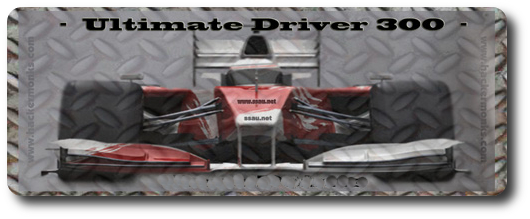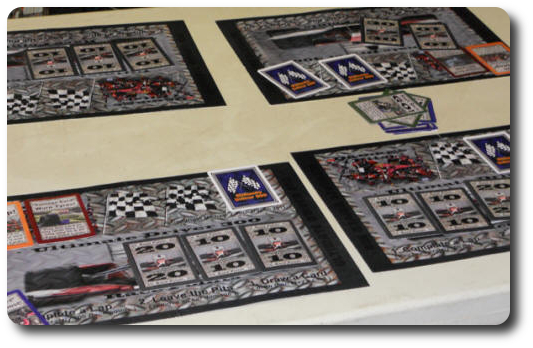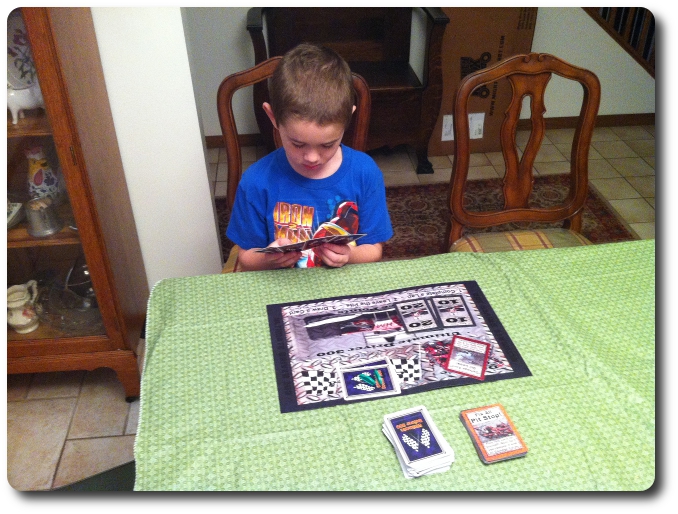
The Basics:
- For ages 7 and up (designer suggests 12+)
- For 2 to 4 players
- About 20 minutes to complete
Geek Skills:
- Counting & Math
- Logical & Critical Decision Making
- Reading
- Strategy & Tactics
- Risk vs. Reward
- Hand/Resource Management
Learning Curve:
- Child – Easy
- Adult – Easy
Theme & Narrative:
- The engine is running and the flag is flying – time to see how well the rubber meets the road and who is the ultimate driver!
Endorsements:
- Gamer Geek approved!
- Parent Geek approved!
- Child Geek approved!
Overview
Ultimate Driver 300 Deluxe is a card game that puts the player in the driving seat and sets them down the track on a high-speed race where only one player can be the winner. The deluxe edition of the game is comprised of 4 Player Mats, 108 cards, and 12 plastic car markers (3 per player, in four different colors).
Cards and Carburetors
Out of the 108 cards included in the game, the set is broken down into five different card groups. These groups and a summary of their role in the game are described here.
Go cards
These cards represent the flag that signals the drivers to slam their peddle down and grip their steering wheel. Until the flag is flown, none of the other cards can be played, but they can be collected for the race to come.
Damage cards
Driving fast is risky and it should not surprise any driver that the car will take a ding and a dent from time to time, as well as major damage. The Damage cards represent the inevitable harm that is inflicted on the car during the race, causing the car’s performance to be reduced.
Pit Stop cards
When enough damage is sustained to a car or when the driver feels it is time to bring the car in for a quick tune-up, the Pit Stop card is played which allows the player to fix the damage, but at the cost of being temporarily out of the race.
Race cards
Every driver has a need for speed and these cards will fully satisfy. Each card represents the car’s speed and range from 10 to 50 “race points” that are added together to track not only the car’s performance, but also the car’s overall lap and race progress.
Event cards
Throughout the race, while jockeying for position, car impacts and debris on the track will appear. The Event cards represent the changes to the track, cars, and to the race as a whole that the drivers must overcome to win.
Drivers, Start Your Engines
To set up the game, give each player a Player Mat and 3 car markers of the same color. Shuffle the deck and deal each player 5 cards, face-down. The players should keep these card hidden from the other players at all times. The remaining cards are placed in the center of the playing area, face-down. Draw the first card from the top of the deck and place it beside it, face-up. This is the discard pile.
The race has begun!
And They’re Off!
Note: If the first card drawn and revealed during game set up is a Go card, the race starts and all cards can be played. However, if the card revealed is not a Go card, the players take turn drawing and discarding cards, always maintaining a hand no bigger than 5 cards at the end of their turn.
A player’s turn is comprised of three possible actions, of which the player can only take one. These actions are as follows:
Draw a Card, Then Play a Card
More times than not, the player will draw a card from the face-down deck and then play a card. Where they play the card is dependent on the card itself. Race cards and Pit Stop cards are played on the player’s Player Mat. Damage cards are always played on an opponent’s Player Mat, and depending on the Event card, on the player’s or an opponent’s Player Mat. The player only gets to draw one card and then play one card, but they must do it in that order. If the Go card has not yet been played, the player simply draws a card and then discards a card from their hand to the discard pile, with five cards remaining in their hand. If the player plays a Go card, and is the first to do so, the race begins! As a reward for playing the Go card, the player immediately gets another turn. Note that once a Go card is played, all the other Go cards are worthless and do not reward the player with an extra turn if played.
Complete a Lap
On a player’s turn, they can play Race cards on their Player Mat. Once the Race cards equal 100 points exactly, they can announce they are completing a lap. The cards are collected on the Player’s mat, flipped over (face-down) and the player puts one of their card markers on the face-down cards, signifying they have completed that number of laps.
Coming Out of a Pit Stop
If the player played a Pit Stop card during their last turn, they can now come out of the Pit Stop and rejoin the race.

Example of Player Mats in use
Damage and Driving
While driving, a car will take damage. Depending on what damage is taken, the player is limited in what cards they can play, but not completely. A player will most likely always be able to play some type of card on their turn. Regardless, the player will “feel the pain” as the cards they cannot play become greater in number which drastically reduces their performance. This is where the Pit Stop cards come into play and allow the player to remove any negative damage and effects, but at a cost. When a player puts their car in a Pit Stop, damage is removed but their place in the race might also have been lost. A player must choose if the risk of removing the damage is worth the reward of being able to play all their cards again. Sometimes, the choice is not at all clear.
Winning the Game
The first player to complete three laps wins the game!
To learn more about Ultimate Driver 300 Deluxe, see the game’s official web site. Note that there is a “basic” version of the game that plays the same way, except there are no Player Mats, no car markers, and only takes 2 players. While not as pretty and unable to take 4 players, removing the additional game bits reduces the cost a great deal and makes the game more portable. See Ultimate Driver 300 (basic version), for details.
Prediction
My little geeks have always enjoyed race games, especially when they are racing cars. Monza and Scooby-Doo! Coolsville 500 was their first taste and they’ve been hooked ever since. The same can be said for my other two test groups, the Parent and Gamer Geeks. There is something universally appealing to “speed” and “racing” that makes such games popular. Of course, some race games do not feel like a race at all, and “speed” is sometimes greatly reduced by the level of game’s complexity. In such cases, theme is all important and game play is there to simply facilitate the story.
Ultimate Driver 300 Deluxe is very straightforward with little in the way of complex thinking that will cause my little geeks to scratch their heads and lose track of their goals. Even the bad stuff you can put on your opponent’s cars are not so terrible as to kick them out of the race entirely. This gives my little geeks a lot of room to maneuver when learning to play the game and determining what they should do next.
My 4-year-old was surprisingly not interested in giving the game a try. In his own words, “I don’t want to play a card game.” Even when I told him that it was a race game, he just didn’t seem enticed enough to give it a try. That was fine and I wasn’t going to push it. After all, you can’t like everything and I’d rather not make games something that my little geeks feel pressured to play or to like. My 7-year-old, had no problem getting excited about the game, however, and eagerly waited for me to join him at the table.
I don’t think my 7-year-old will have any problem grasping the rules of this game and playing it well. He has played much more complex and lengthy games than this one and has proven to be an excellent student and player, picking up a game’s subtle game play fairly early. What he lacks in experience he makes up for in pure drive. In short, he’s a tenacious little fellow.
After I pitched the game to him, explained the rules, demoed how the cards works, and shared some possible strategy, tips, and tricks, he was ready to race! While he shuffled the cards and dealt all the player’s their first hand, I asked him his thoughts on the game so far.
“I like the theme and the rules are pretty easy to understand. I think the trick is going to be knowing what to play and when.” ~ Liam (age 7)
Well put. Of course, most games are like that, but we must keep in mind that this is coming from the mind of a 7-year-old who is learning what games are all about. He’s already anticipating what a game’s challenge is going to be and has enough game experience under his belt to recognize game mechanisms and how they are used just from reading the game rules. If ever there was a Geek in Training, it is him.
Let’s get this game started and see if it crosses the finish line or runs out of gas.
Final Word
Ultimate Driver 300 Deluxe was very much liked by my little geek. He particularly enjoyed the fact that he had so many cards (six in total) to use each turn. He seldom used the Pit Stop card, preferring to keep his car moving with what cards he could use. More times than not, he was able to play a card that either helped him advance or a card that slowed the other player’s down. What he did not like was the amount of attention he received once he was the lead car. He likened it very much to a video game he enjoys playing, Super Mario Kart, where the lead car is a giant target on wheels. When he was being loaded down with negative cards, he felt a bit “picked on”, but when he slowed down and let another player get up front, he had no qualms about returning the favor.
Parent Geeks also enjoyed the game, as did non-gamers. The game play is very straightforward and simple. The most time and attention given on any player’s turn will be simply trying to figure out what cards to play and when. Most of the time, the choices are obvious. The only time a player might vapor lock is when they are confronted with a choice that could tip the race in another player’s favor, or they simple do not have a card that appears to advance them. But, again, more times than not, a player will always have a card to play.
Gamer Geeks enjoyed the game, but not overly so. It was a fun diversion (which all games should be), but its level of simplicity, which made it accessible to Parent and Child Geeks, made it less challenging to the Gamer Geek elitists. Of course, the Gamer Geeks made the game into a blood bath with the primary focus on crippling their opponent’s cars to a point where a Pit Stop was not only necessary, but the only thing the player could do to move their car. These games were brutal and tended to take longer than the others where the focus was on racing and being first, versus smashing the competition. Remember, you can only play one card at a time, so you can either harm an opponent or work towards a win.

My little geek contemplates his next move carefully, while I prepare my next move – note, he is winning by a full lap!
Gamer Geeks, this game is approved as you will enjoy it. Just don’t expect to flex all your elitist muscles while playing the game. The trick is balancing hindrance and advancement, but the game itself is somewhat designed to play a role that is squarely in the middle. None of the cards you can add to a player completely destroy them and none of the cards you can play on yourself give you a guaranteed win. Advancement and damage is gradual. This gives all the players a lot of maneuverability, but there is nothing that you or any other player could throw down to be a game changer. This reduces the level of excitement, obviously, as well as reduces the level of complexity. Still fun to play and a quick game to bring out for game night openers or closers. Approved for fun and speed, rather than in-depth challenge.
Parent Geeks, this is an easy to learn and easy to play race game that can be played with a mixed age and experience group. There is enough to the game to keep everyone engaged and talking at the table. Odds are, if your family is anything like mine, another race will be requested before you even have a chance to put the game away. The damage cards are not what I would call “wrecking”. They limit and hinder, but do not put a player out of the race. Of course, if the player lets them build up, their choices are reduced, but gradually. This provides the younger players and inexperience players enough time to evaluate and keep playing without feeling shutdown and left in the dust.
Child Geeks, this is a great card game to learn as it opens the door to more complex games down the road (no pun intended…well…OK, a little intended). You will have to manage your own car’s damage and determine when it is time to roll into the Pit Stop to fix everything which will make your car faster, but by doing so you lose your place in the race. You’ll also have to balance your position. Too much in front makes you a target. Too much in back makes it difficult to keep up. You’ll need to keep yourself in the middle and always at the ready to jump ahead. Hand management is a must as is keeping an eye out for opportunity.
I personally found Ultimate Driver 300 Deluxe to be a fairly “meh” game. I could take it or leave it, found it fun but not engaging, and was somewhat disappointed with the lack of complexity. Of course, the game is meant to be challenging without being hard and straightforward without a lot of confusion or delay. It isn’t going to be a game I will turn down, but nor is it going to be a game I make an evening out of. “Simple and good” is the best way to summarize Ultimate Driver 300 Deluxe and it does its job well. Entertains without being taxing, is fun without feeling like work, and allows players to be social and play at the same time. It makes for a fun game to play with my kids, family, and friends. As such, I give the game full marks for succeeding. It made me smile, allowed me to have fun with my little geeks, and I would gladly play it again for these reasons. If you are looking for such a game, do give Ultimate Driver 300 Deluxe a look the next time you take a spin around the Interweb.
This game was given to Father Geek as a review copy. Father Geek was not paid, bribed, wined, dined, or threatened in vain hopes of influencing this review. Such is the statuesque and legendary integrity of Father Geek.



